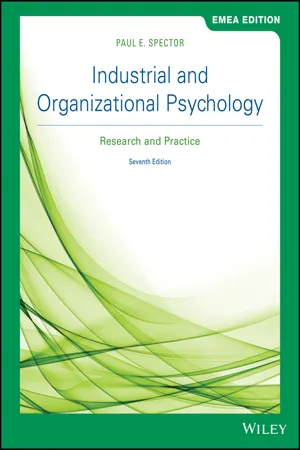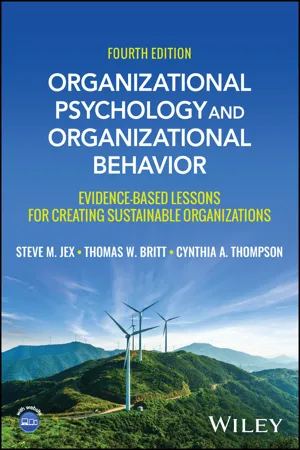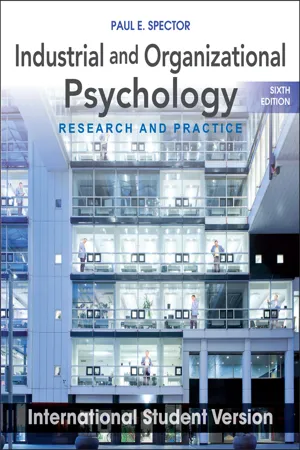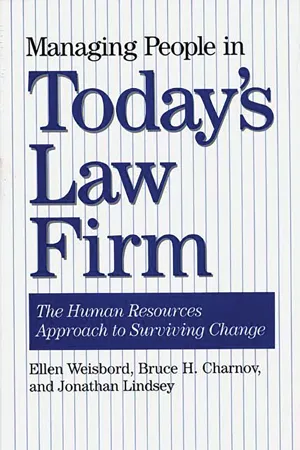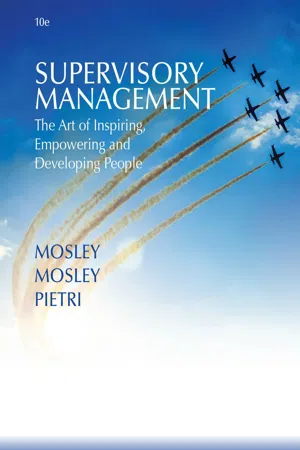Business
Modern Motivational Theory
Modern motivational theory in business emphasizes the importance of intrinsic motivation, focusing on factors such as autonomy, mastery, and purpose. It recognizes that individuals are driven by more than just financial rewards and seeks to create a work environment that fosters engagement and fulfillment. This approach acknowledges the diverse needs and motivations of employees, aiming to enhance productivity and satisfaction.
Written by Perlego with AI-assistance
Related key terms
1 of 5
7 Key excerpts on "Modern Motivational Theory"
- eBook - PDF
Industrial and Organizational Psychology
Research and Practice
- Paul E. Spector(Author)
- 2020(Publication Date)
- Wiley(Publisher)
This chapter discusses job performance in terms of several popular theories, with a focus on motivation rather than ability. (In Chapter 10, we will explore other things that affect performance, as well as other forms of work behavior, such as turnover.) This chapter begins by defining motivation in the context of the work environment. It then introduces work motivation theories and provides a brief overview of the nine theories to be covered. Each theory is next discussed in greater detail, along with the research evidence for its validity. Theories of Employee Motivation Work Motivation Theories 185 What Is Motivation? Motivation is defined as an internal state that induces a per- son to engage in particular behaviors. From one perspective, it has to do with the direction, intensity, and persistence of behavior over time. Direction refers to the choice of specific behaviors from a large number of possible behaviors. For example, an employee might decide to volunteer for an extra work project that will require him or her to work overtime instead of going home on time and watching television. Intensity refers to the amount of effort a person expends at doing a task. If an employee is asked to sweep a floor, the person can exert a lot of effort by sweeping hard and fast or exert a little effort by sweeping softly and slowly. Persistence refers to the continuing engagement in a behavior over time. An employee might try to accomplish something over an extended period of time, such as studying to pass the CPA exam to become a certified public accountant, even though it might take several attempts. From another perspective, motivation is concerned with the desire to acquire or achieve some goal. That is, motivation derives from a person’s desires or wants. Some people, for example, are highly motivated to acquire money. It is presumed that a high level of motivation to have money affects the behavior relevant to acquiring it. - eBook - PDF
Organizational Psychology and Organizational Behavior
Evidence-based Lessons for Creating Sustainable Organizations
- Steve M. Jex, Thomas W. Britt, Cynthia A. Thompson, Cynthia A Thompson(Authors)
- 2024(Publication Date)
- Wiley(Publisher)
Clearly, researchers are only beginning to examine how social forces within an organization can shape employee motivation and performance. CHAPTER SUMMARY The first major section of this chapter reviewed what are considered to be the major theories of motivation in organiza- tional research and how organizations have used ideas from these models to enhance motivation. The major theories covered included expectancy theory, goal-setting theory, behavioral theories, SDT, and JCT. The Expectancy and Goal Setting theories are both cognitively oriented, addressing how employees think about the connection between behaviors and outcomes. The Behavioral Approach to employee motiva- tion involves using principles adapted from behaviorism to influence behavior in organ- izations. The principle used most frequently is reinforcement, although others, such as punishment, shaping, and extinction, may be used in certain situations. SDT empha- sizes the importance of not only the quan- tity, or amount, of motivation, but the quality of that motivation. Proponents of this theory state that employees driven by autonomous motivation at work will be more satisfied and perform better than employees who experience their behavior as controlled by others. This theory has received a great deal of support outside of the organizational context and generated a great deal of research in recent years. The second major section of the chapter examined how organizations have applied these theories to influence employee motiva- tion. Without a doubt, the most widely used mechanism that organizations use for moti- vating behavior is reward systems. Tangible rewards include merit pay, incentive pay, bonuses, and fringe benefits. Research over the years has shown that tangible rewards such as pay can be very powerful motivators of employee behavior. - eBook - PDF
Industrial and Organizational Psychology
Research and Practice
- Paul E. Spector(Author)
- 2014(Publication Date)
- Wiley(Publisher)
They also explain other types of work behavior 187 188 Chapter 8. Theories of Employee Motivation that do not involve job performance. Most of the theories, however, have focused on job performance because job performance has been a central variable for the I/O field. This chapter discusses job performance in terms of several popular theories, with a focus on motivation rather than ability. (In Chapter 10, we will explore other things that affect performance.) It also covers explanations for other forms of work behavior, such as turnover. The chapter begins by defining motivation in the context of the work environment. It then introduces work motivation theories and provides a brief overview of the nine theories to be covered. Each theory is next discussed in greater detail, along with the research evidence for its validity. Objectives: The student who studies this chapter should be able to: Define motivation. List the major work motivation theories that are discussed in this chapter. Describe how each of the major work motivation theories explains work behavior. Compare and contrast the major work motivation theories. WHAT IS MOTIVATION? Motivation is generally defined as an internal state that induces a person to engage in particular behaviors. From one perspective, it has to do with the direction, intensity, and persistence of behavior over time. Direction refers to the choice of specific behaviors from a large number of possible behaviors. For example, an employee might decide to volunteer for an extra work project that will require him or her to work overtime instead of going home on time and watching television. Intensity refers to the amount of effort a person expends at doing a task. If an employee is asked to sweep a floor, the person can exert a lot of effort by sweeping hard and fast or exert a little effort by sweeping softly and slowly. Persistence refers to the continuing engagement in a behavior over time. - eBook - PDF
Managing People in Today's Law Firm
The Human Resources Approach to Surviving Change
- Bruce H. Charnov, Jonathan Lindsey, Ellyn Weisbord(Authors)
- 1995(Publication Date)
- Praeger(Publisher)
2 Motivational Theories: A Practical Primer Motivation is unquestionably one of the universal concerns of management, directly and inextricably tied to job performance. Highly motivated people are productive people; in addition, motivation both increases personal satisfaction and decreases absenteeism and turnover. As a result, motivation is a basic tenet in our assumptions about good leadership, and the question of how to motivate employees has been one of the most frequently investigated topics in management literature. In the past, the issue of motivation was not explicitly addressed in law firms. Among the principal sources of motivation in the modern law firm has been fear, pure and simple—fear of not making partner, fear of not winning choice assignments that will allow a junior lawyer to become skilled in the profession, fear of being terminated (‘‘encouraged to seek other career opportunities,’’ as one firm put it). Thus, the abundant financial and personal rewards of part- nership—and the fear of missing out on those rewards—provided motivation enough. Associates came on board from law school knowing the score: If they worked with dedication and perseverance and if they had the right stuff—a combination of knowledge, skill, hard work, and charisma—they would make the cut and reap the rewards. Although not everyone would make it, everyone understood the rules, and nearly everyone coveted the prize. Mix the power of partnership with the innate ambition of these ‘‘high need for achievement’’ types and you have a powerful tool for productivity. The situation has changed. Partnership is neither as certain nor as coveted a prize as it once was. Associates have to wait as long as nine or ten years to make partner, compared to six or seven in years past. And the chances of making partner by the traditional ‘‘up or out’’ route are diminished. Fewer associates are promoted, there are more permanent, nonpartner status posi- - eBook - PDF
- Michael A. Hitt, C. Chet Miller, Adrienne Colella, Maria Triana(Authors)
- 2017(Publication Date)
- Wiley(Publisher)
Pay, while important, often takes a backseat. There are many ways to motivate people, and a great deal is known about how to most effectively achieve strong motivation. In this chapter, we describe the major theories of work motivation and the practices that are most likely to increase and sustain strong efforts. We begin by formally defining what is meant by motivation. Next, we describe fundamental theories of work motivation, including both content and process theories. To synthesize these theories, we close the main body of the chapter by distilling useful management practices. What Is Motivation? Man and machine . . . work in close harmony to achieve more than either could alone. Machines bring precision and capacity. They make our lives easier, perfect our processes, and in many ways, enrich our quality of life. But people possess something that machines don’t—human spirit and inspiration. Our people work continuously at setting goals and tracking results for ongoing improvement as an overall business. They are an inspiration and their goals and accomplishments have won Branch-Smith Printing recognition on the highest of levels. 2 This quotation from Branch-Smith Printing, a recipient of the Malcolm Baldrige National Quality Award, gets at the heart of motivation: it is the spirit and inspiration that leads peo- ple to apply their human capital to meet the goals of the organization. In Chapter 1, we dis- cussed the strategic importance of human capital to the success of a firm. However, human capital alone is not enough to ensure behaviors that support organizational performance. Associates must translate their human capital into actions that result in performance impor- tant to the achievement of organizational goals. Motivation is the process through which this translation takes place. Consider the following example. A manager has three assistants reporting to her. They have similar levels of experience and education. - eBook - PDF
Skills of Management and Leadership
Managing People in Organisations
- W. David Rees, Christine Porter(Authors)
- 2017(Publication Date)
- Red Globe Press(Publisher)
Expectancy theories Another perspective that needs to be integrated with the previously explained theories is that provided by the expectancy school of motivational theorists. The expectancy approach attempts to overcome one of the criticisms of other motivational theories by accounting for individual differences. The general thrust of this approach is to examine whether or not whether incentives are in line with employee expectations. It follows that it is necessary to check whether the reward system in an organization actually works in the way that it is intended to work. It is no good, for example, expecting to motivate people by offering incremental sal-ary increases or promotion on the basis of merit if the reality is that such rewards are based on seniority or some other factor not connected with merit. Employees are likely to make judgements about what reward system really operates by what they believe is actually happening, rather than by statements of organizational policy. Even if rewards are based significantly on merit it is necessary to convince people of that, as motivation is likely to depend on what people perceive to be happening. It is also necessary to review how equitably rewards are distributed. Even if people are inclined to respond to a particular incentive, they may be discouraged from doing so by per-ceived unfairness in the way in which rewards are distributed. The relation-ships between the rewards given to different people may therefore need to be examined, as well as the size of the rewards. The gap between intended and actual reward systems can be alarmingly high. As is explained in the next chapter, some reward systems can degenerate into arrangements for restrict-ing rather than increasing performance. Impact of national culture When considering theories of motivation and seeking to improve employee motivation via reward structures or redesigned jobs, the poten-tial impact of national culture needs to be taken into account. - eBook - PDF
Supervisory Management
The Art of Inspiring, Empowering, and Developing
- Donald Mosley, Donald Mosley, Jr., Paul Pietri, , Donald Mosley, Donald Mosley, Jr., Paul Pietri(Authors)
- 2018(Publication Date)
- Cengage Learning EMEA(Publisher)
201 expectancy theory, p. 203 goal-setting theory, p. 206 equity theory, p. 207 reinforcement theory, p. 208 job characteristics model, p. 209 traditionalists, p. 212 Baby Boomers, p. 212 Generation Xers, p. 213 Generation Yers, p. 213 Generation Zers, p. 213 Discussion Questions 1. Identify and explain the three levels of employee motivation. Give an example of each for one of the situations below: • Customer associate at Home Depot • Bagger at grocery chain • Carpenter for construction company Copyright 2019 Cengage Learning. All Rights Reserved. May not be copied, scanned, or duplicated, in whole or in part. Due to electronic rights, some third party content may be suppressed from the eBook and/or eChapter(s). Editorial review has deemed that any suppressed content does not materially affect the overall learning experience. Cengage Learning reserves the right to remove additional content at any time if subsequent rights restrictions require it. Chapter 7: Motivation 219 2. Explain the relationship between motivation and job performance. Can you identify a situation in which a factor other than your skill or motiva- tion level affected your performance? 3. Briefly outline Maslow’s theory of the hierarchy of needs. What need levels are addressed by • Being promoted from operator to supervisor • Setting a new record for individual performance • Being selected to attend a special training course 4. In what ways did Frederick Herzberg’s research concerning employee motivation correlate with Maslow’s hierarchy of needs? 5. In a management seminar taught by one of the authors to supervisors in a large shipyard, one supervisor commented: “We have very little opportunity to ‘motivate’ employees. All mone- tary factors—starting pay, yearly merit increases, and bonuses based on the yard’s profits—are controlled by upper management, with no input from supervisors. We don’t have anything to motivate with.” Do you agree or disagree with this supervisor? Why? 6.
Index pages curate the most relevant extracts from our library of academic textbooks. They’ve been created using an in-house natural language model (NLM), each adding context and meaning to key research topics.
